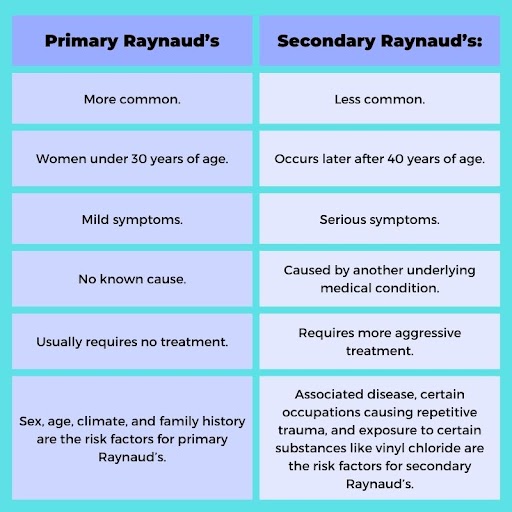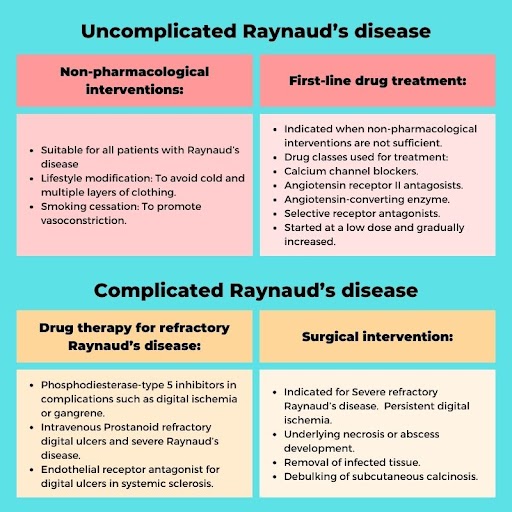What Is Raynaud’s Syndrome?
When someone is subjected to cold weather or stress, they develop Raynaud's phenomenon (RP). It is characterized by a decrease in blood flow to the fingers and toes. Colors such as white, blue, and red are frequently seen on the fingers and toes. The sense of "pins and needles" (numbness) or discomfort may accompany. These symptoms come and go in "episodes" or "attacks," and they usually go away by themselves. Raynaud's disease affects not just your fingers and toes but also your nose, lips, ears, and even your nipples. It can take up to 15 minutes after your warm-up for normal blood flow to restore to the area.
What Are the General Causes of Raynaud’s Syndrome?
Stress and cold weather leading to spasms of minor peripheral vessels are the two main causes of Raynaud’s syndrome.
What Sorts of Cold Exposure Can Result in Raynaud’s Syndrome?
-
Reaching into a freezer
-
Being close to an air conditioner.
What Is the Difference Between Raynaud’s Disease and Raynaud’s Syndrome?
Raynaud’s phenomenon is also called Raynaud's disease or Raynaud’s syndrome.
What Are the Types of Raynaud’s Disease?
There are two types of Raynaud’s disease:
-
Primary Raynaud’s.
-
Secondary Raynaud’s.

What Are the Causes of Secondary Raynaud’s?
-
Connective Tissue Diseases: Lupus, rheumatoid arthritis, and Sjogren's syndrome.
-
Diseases of the Arteries: Pulmonary hypertension.
- Carpal Tunnel Syndrome: The pressure on major nerves causes numbness and pain in hand, which is susceptible to cold temperatures leading to Raynaud’s disease. Repeated action or vibration for longer periods can lead to overuse injuries. Smoking causes narrowing of blood vessels, likewise the injuries to the hands or feet. This is known as carpal tunnel syndrome.
- Medications:
- Beta-blockers for high blood pressure.
-
Migraine medications that contain Ergotamine and Sumatriptan.
-
Attention-deficit or hyperactivity disorder medications.
-
Chemotherapy agents.
-
Drugs that cause blood vessels to narrow, and cold medications.
How to Diagnose Raynaud’s Syndrome?
History:
Age is noted to distinguish between primary and secondary Raynaud’s. Thumb involvement is more common in secondary Raynaud’s. Asymmetrical Raynaud’s disease is a large vessel disease. Occupational history is asked whether the patient is under the usage of vibrating tools.
Medical and drug history helps to rule out chemical exposure. Family history is potentially associated with autoimmune or rheumatological disease.
Examination:
Extremities should be focused on signs of systemic diseases for secondary Raynaud’s - digital ischemia. Cutaneous manifestations of systemic sclerosis are skin thickening (scleroderma), including the digits (sclerodactyly), calcinosis (subcutaneous calcium deposition), and telangiectasias (dilated blood vessels). Low volume or absent peripheral pulse requires urgent investigation like arterial Doppler ultrasound. Cardiovascular and respiratory examinations are done for pulmonary fibrosis and hypertension.
Investigations:
Primary Raynaud’s:
-
Complete blood count.
-
Inflammatory Markers - Erythrocyte sedimentation rate or C-reactive protein.
-
Antinuclear antibody (ANA) and nail fold capillaroscopy.
-
Autoantibody Testing - To identify a connective tissue disease.
-
Extractable Nuclear Antibody Testing - To determine the antigenic target of autoantibodies.
-
Routine Biochemistry - Renal and liver function tests.
-
Bone Biochemistry - To measure the proteins, minerals, and enzymes in bones.
-
Paraproteinaemia - Creatinine kinase, immunoglobulins with serum electrophoresis.
-
Older Patients With Cardiovascular Disease - Complements C3 and C4, fasting lipid profile.
-
Chest X-ray - Vascular thrombosis and pregnancy morbidity and mortality.
-
Testing for Antiphospholipid Syndrome - Anticardiolipin and anti-b2-glycoprotein antibodies and lupus anticoagulant.
-
Infrared Thermography - To measure the skin surface temperature and tissue perfusion.
What Is Nail Fold Capillaroscopy?
Capillaroscopy can be done with:
-
A low-magnification examination (∼×10 magnification) using a variety of devices (dermatoscopy, stereomicroscope, or ophthalmoscope): Provide a wide field of examination of the nail fold.
-
A high-magnification examination (∼×200–600 magnification) using video capillaroscopy: Detailed examination and quantification of the microvasculature.
-
It is usually done at the base of the fingernails, where the capillaries lie parallel to the skin's surface.
-
Normal Capillaries: Uniform, regularly distributed, and hairpin-like appearance.
-
Abnormal Findings:
-
Dilated capillaries.
-
Hemorrhages in frequent giant capillaries.
-
Loss of capillaries is called ‘drop out.’
-
‘Ramified’ or bushy capillaries.
-
‘Fast track’ algorithm to differentiate non-scleroderma and a scleroderma pattern.
-
How Is Raynaud’s Syndrome Treated?
There are various treatment strategies for uncomplicated and complicated Raynaud's disease based on the intensity of the disease and compatibility of the patient. They are as follows:
Who Treats Raynaud’s Disease?
Rheumatologists are specialists who specialize in the diagnosis and treatment of arthritis and associated joint, muscle, and bone illnesses. Hence they are the best qualified to diagnose Raynaud's phenomenon. Patients might also get advice from them on the best treatment alternatives.
What Are the Complications of Raynaud’s Disease?
Small, painful sores can form on the tips of the fingers or toes in those with severe Raynaud's phenomenon. In rare circumstances, a prolonged absence of oxygen to tissues might result in gangrene. Gangrene is the cellular death and decay of body tissues.
Is Raynaud’s Disease Fatal?
No, Raynaud’s disease is not fatal. However, severe cases can cause tissue injury cutting off blood flow to the skin. Skin ulcers or gangrene can result from a completely clogged artery. To amputate a finger or toe is the treatment for gangrene.
Conclusion:
Raynaud’s disease is a prevalent disorder that has a high rate of morbidity. A thorough clinical assessment is essential. Future research is needed to better understand the complicated pathophysiology as well as outcome measures of treatment success in order to create more effective management strategies.














